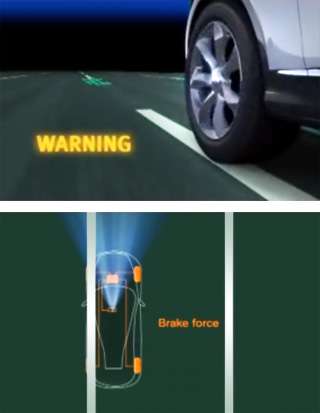
SANTA MONICA, CA – The latest example of collision-avoidance technology, designed to prevent a vehicle crash before it happens, will debut on the ’08 Infiniti M large sedan in November and new EX cross/utility vehicle in December.
The new Lane Departure Prevention (LDP) takes Nissan Motor Co. Ltd.’s lane departure warning (LDW), which first debuted in 2004 on the Infiniti FX cross/utility vehicle, to the next step.
LDW uses a rear-view mirror-mounted camera to look ahead and chart the vehicle’s path by measuring the lateral distance between lane markers. By mating this technology to the vehicle’s stability control system, LDP is able to keep the car on the road by correcting its path.
“When you’re getting too close to the lane markers, the first thing (LDP) will do is beep and also give you a visual signal that you are approaching the lane (line),” says Bob Yakushi, director-product safety and environmental for Nissan North America Inc., at a recent media event here.
“If you continue to ignore that, it will now engage the vehicle dynamic control system and activate the brakes on the opposite side of your drift. So if you’re drifting left the brakes will apply on the right side to gently pull you back into the lane.”
Moving the steering wheel to correct a drift stops the VDC intervention. Additionally, “The system works at a speed of about 45 mph (72 km/h) and will not operate if you turn your turn signal on, because it assumes you know what you’re doing,” Yakushi says.

Nissan is aware such avoidance technology may rub driving enthusiasts the wrong way, so it allows the LDP to be activated via a steering wheel- mounted button.
When the LDP system is engaged, a green light is visible near the tachometer’s 3,000-rpm mark. However, the driver must activate the system manually, as it is not automatically engaged when the vehicle is started.
Although LDW is active even when LDP is off, it too can be de-activated, by pressing the main power buttons below the driver’s left-side vents for five seconds.
Yakushi says Nissan classifies LDP as the first non-emergency technology of its kind and wanted it to be manually controlled. “Since we’re the first to introduce this, we want the customer to acknowledge they want to have this type of intervention while driving.”
Stefan Conrady, EX product manager, says LDP “never interferes with your intentional direction.”
Along with other technologies, such as the new Around View Monitor that displays a simulated overhead view of the EX at speeds under 10 mph (16 km/h), LDP is a “technology that helps keep your interactions with the vehicle easier and more intuitive,” he says.
Yakushi says passive safety has reached a pinnacle in the U.S., noting that for the last 25 years more conventional safety technologies, such as airbags and seatbelts, have reduced the fatality rate, but only to a degree.
He says Infiniti, along with the National Highway Traffic Safety Admin., is focusing on pre-crash – what happens before the accident (and) how we (can) reduce the 55% (U.S. fatality rate).”
Yakushi acknowledges LDP is not foolproof. Under certain driving conditions, such as heavy fog, the system may not work if the camera cannot detect lane lines. Nevertheless, if one line is visible, LDP can project where the other likely is located.
Infiniti plans to roll out LDP on all of its new or redesigned models.




